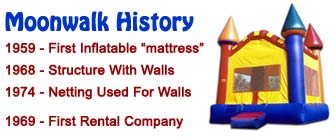History and Invention of Inflatable Moonwalks

Inflatable Moonwalks
The first inflatable structure was designed and invented in 1959 by John Scurlock in Shreveport, Louisiana who was experimenting with inflatable covers for tennis courts, swimming pools, and other enclosures when he noticed his employees enjoyed jumping on the covers. The loss and refilling of air made them bouncy and the employees kept flopping and jumping on them and having a great time. Scurlock decided to create a kid’s amusement bouncer and started the first inflatable moonwalk business – Space Walk. At the time, the devices were referred to as Moon Walks, although many different terms to describe them have come into use.
He first started out with a large air mattress – Space Pillow. In 1967-1968, he decided to add walls. At that time, there were two inflatable fans- one for the mattress and one for the walls. Windows were made of solid clear plastic and were enclosed like a bubble. This caused the inside to get very hot in the summer. Big improvements came in 1974 when the “Jupiter Jump” was introduced- it was the first unit to support use of netting for the walls. This solved the issue of hot temperatures inside the inflatable. Juniper Jump was round and shaped like a liberty bell. The first characters started appearing in the late 70’s.
Space Walk was the first company to bring an inflatable to the IAAPA convention, Showmen’s Club and the American Rental Association.
Moonwalk Rental Companies
People started calling to ask to use the inflatables, so Frances Scurlock (John’s wife) started renting them, and inevitably started the very first inflatable rental company. In 1969, she charged $19.95 for 24 hours.
Back in the early days, people bought inflatable moonwalks only for fairs and carnivals- the price was prohibitive. Festivals are now a secondary market and the home and event rental of moonwalks is the dominant use.
Other names
Worldwide, moonwalks are referred to as jump castles, jump houses, bounce houses, bouncers, inflatable bounces, moonwalks, jumpy things, spacewalks, inflatable rides, or bouncy castles among many other terms. The inflatable amusement industry has grown to include various other amusement devices such as slides, obstacle courses, and climbing walls.
Biggest Inflatable
The biggest bouncy castle ever made was in Canada by two inventors. They started in 1994 and finished it in 1996. Although it has never been blown up for public use it is believed to have 61 floors in a height of 157 ft (48 m) and 400 ft (120 m) wide. Some people have valued it at $200,000 but health and safety officials have deemed it too unsafe to be used and probably for good reasons. There are 20 obstacle courses and one giant slide which is believed to be over 100 ft (30 m) high with two drops in the middle. Other features include zip wires, ball pits, a main stairwell and balconies.







